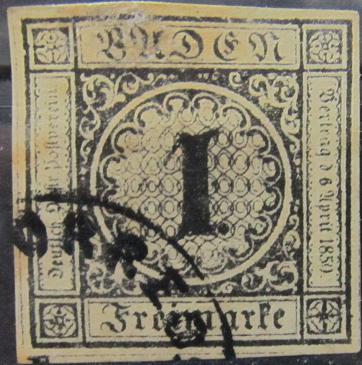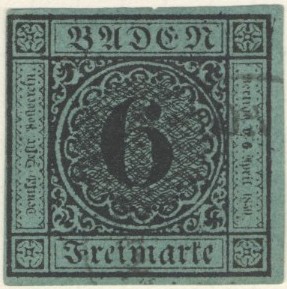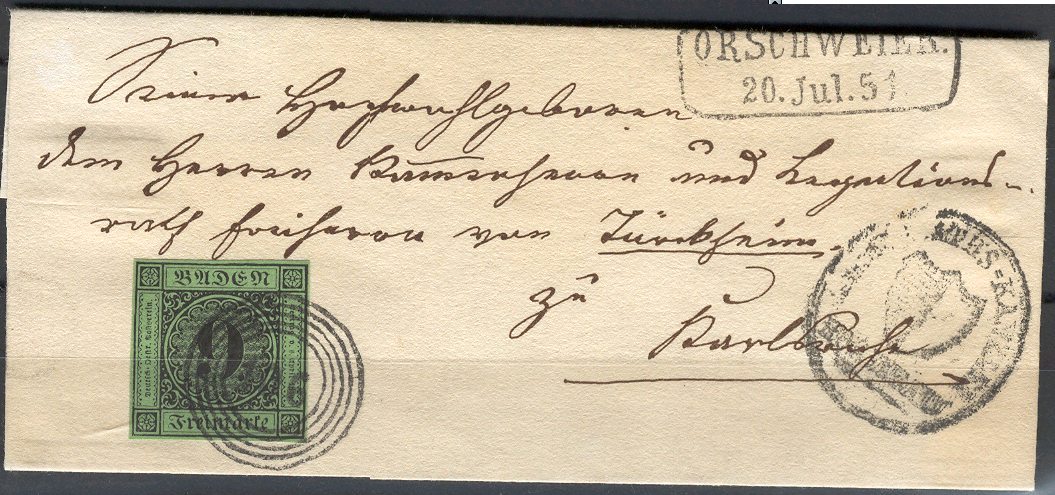 |
|||||
|
|||||
| Preview of Stamps Catalogue: VOLUME 1 |
 |
|||||
|
|||||
| Preview of Stamps Catalogue: VOLUME 1 |
Bade
Return To Catalogue - Baden 1860-1868 - Baden 1862 forgeries - Baden miscellaneous - Other German States - Germany - Baden, French Occupation Zone (1945)
Currency: 60 Kreuzer = 1 Gulden
Note: on my website many of the
pictures can not be seen! They are of course present in the catalogue;
contact me if you want to purchase it.
One of the German States. A Grand Duchy in the south-west of Germany. Chief towns are Mannheim, Freiburg and Heidelberg. It issued stamps from 1851 to 1871, it used the stamps of the German Empire afterwards.
1 Kr black on grey 1 Kr black on white (1854) 3 Kr black on yellow 3 Kr black on green (1854) 3 Kr black on blue (1858) 6 Kr black on green 6 Kr black on yellow (1854) 9 Kr black on lilac
For the specialist: A very rare misprint exists: the 9 Kr black on green (the colour of the 6 Kr instead of lilac), only a handfull of these misprints have survived (3), they were only discovered in 1893. The history of these misprints can be read in the book 'Die Briefmarken von Altdeutschland' by K.K. Doberer (in German). These stamps were printed by Mr. Hasper of Carlsruhe. The printed numbers in the next table were obtained from the "Handbuch für Postmarkensammler für den permanenten Gebrauch Bestimmt (1881)" by Ferdinand Meyer.
Value of the stamps |
|||
vc = very common c = common * = not so common ** = uncommon |
*** = very uncommon R = rare RR = very rare RRR = extremely rare |
||
| Value | Unused | Used | Remarks |
| 1 k black on grey | RRR | RR | Printed in sheets of 45; five rows of nine (1st May
1851), Later in sheets of 50 (August 1851); Total amount printed 736,780 |
| 1 k black on white | R | ** | Printed in sheets of 100 (January 1854); Total amount printed 5,123,100 |
| 3 k black on yellow | RR | * | First printing black on orange in sheets of 90 (1st
May 1851) Second printing black on yellow in sheets of 100 (August 1851). Total amount printed: 6,157,660 stamps. |
| 3 k black on green | RR | * | Issued in February 1854 in sheets of 100. Total amount printed 12,370,500 stamps. |
| 3 k black on blue | RRR | * | The green paper of the 1854 was difficult to gum and
thus blue color was used instead (issued December 1858). Total amount printed 4,132,400 stamps. |
| 6 k black on green | RRR | *** | First printing black on bluish-green in sheets of 90
(1st May 1851) Second printing black on yellow green in sheets of 100 (August 1851). Total amount printed 2,558,540 stamps. |
| 6 k black on yellow | RRR | * | Issued in February 1854 in sheets of 100. Total amount printed 5,605,200 stamps. |
| 9 k black on lilac | *** | * | Printed in sheets of 90 (1st May 1851). Total amount
printed 6,276,040 stamps. 9 k black on white exist through bleaching of the paper (naturally or artificially). |

(5-ring cancel with numerals in the center)

Red numeral cancel
The 5-ring cancel seems to be the most common. For more information on cancels click here.
All these stamps were officially reprinted (slightly different colours) in 1867; except for the 9 k value.


(Left: reprint, right: possible reprint)

(Reprints)
These reprints were printed in sheets of 20 (4 rows of 5 stamps); 5000 stamps of each value were printed.
Forgery detection: The genuine stamps have the following characteristics; the '5' in '1850' should be smaller than the other letters. The 'F' of 'Freimarke' should not touch the frame. In the 3 Kr values we can find a secret sign (engravers mark) just below the top of the inner circle. A small line is added in the design (see picture below). If a stamp doesn't have this mark, then it is a forgery:



Distinguishing characteristics for the 1 Kr (left), 3 Kr (middle)
and 9 Kr (right)
Similar signs can be found for the 1 Kr, the
secret sign is now in the lower left hand side of the inner
circle. For the 6 and 9 Kr the sign is at the lower right hand
side of the circle.
Furthermore, the stamps are printed quite close together, the
maximum margin between two stamps is 1 mm.
The "Handbuch für Postmarkensammler für den permanenten Gebrauch Bestimmt (1881)" by Ferdinand Meyer mentions a dangerous forgery where the dot from 'v.6' is missing on thick paper. This forgery usually has the cancel '104'. I have never seen this forgery.
The 1851 1 Kr black on grey stamp is quite scarce. Forgers have therefore tried to convert the cheaper stamps of 1853 (1 Kr black on white) into this stamp. It seems that they did this placing the stamp in hot tea or coffee (see also the Serrane guide). However, the starch in the paper also dissolved at the same time during this process. This provides us with a way to detect these forgeries: lay the stamp flat on the water, if the water does not readily soak into the paper then it probably is genuine. If it has then the stamp probably was changed by the 'coffee' method. (Source: 'Fakes & Forgeries of Germany & Colonies' by the Germany Philatelic Society Inc, 1966).



Forgery of the 1 k with a too large top right hand side of the
central "1". The "D" of "Deutsch"
is placed too low. The tail of the "P" of
"Postverein" touches the line next to it. The
"F" of "Freimarke" touches the line on top of
it. I've seen it with a numeral "24" cancel, and a
"CORREOS" cancel.




3 k, 6 k and 9 k forgeries with the text in the left hand label
written too large. I've also seen the 3 k black on blue of this
particular forgery type. The 'F' of "Freimarke' is also too
big. If my information is correct, these are cut outs from a
Menke-Huber postcard (Zurich, around 1902) commemorating the
first stamps of Baden with 'Die Ersten Briefmarken von Baden.'
printed on top. This postcard has five reproductions on it: 1 k
black on grey, 3 k black on yellow, 6 k black on green, 9 k black
on lilac and 3 k black on blue. Similar cards exists for Bavaria,
Wurttemberg, Basel etc. Cuts from these cards can sometimes be
found and presented as 'genuine.
The above stamp is another forgery, note the bottom inscription "Freiwarke" with a "w"! All the inscriptions, especially "BADEN" and "Freimarke" are slightly different from the genuine stamps. There is no secret mark in the above forgery.




Forgeries of the 3 k black on yellow and 6 k. The 'F' of
'Freimarke touches the line above it. The printing is also quite
badly done.


In the above two forgeries of the 9 k value, the '9' is slanting
forwards. I've also seen it with a cancel consisting of parallel
lines. Next to it a forgery of the 6 k made by the same forger
(I've also seen this forgery in black on yellow); it has the '6'
slanting backwards. In both forgeries, the "Vertrag v
o" has a line between "v" and "o". Also,
the second "e" of "Freimarke" is not slanting
forwards enough.

Forgery of the 6 k black on green with the "6" slanting
backwards.

Probably a genuine 9 k stamp, chemically changed to 9 k black on
green 'misprint'.

Two forgeries of the 1 k value with a very large "6" at
the right hand side.

Very primitive 9 k forgery with no dot behind the "9".

A very badly done forgery: 9 k green. This forgery was offered
with a larger margin but with "FACSIMILE" printed at
the bottom. I've seen it pasted on a card with "World's
rarest Stamp series" printed on it. The price was US$0.10.
I know of attempts to change the 9 Kr black lilac into the 9 Kr black on green by chemical means. See the Serrane guide for more information.
More recently (somewhere in the 1980's) the forger Peter Winter made forgeries of the misprint 9 k black on green (even on forged letters). He also seems to have forged the normal 9 k black on lilac. They look very modern:

(Peter Winter forgery on forged letter)

Another Winter forgery on a forged letter to 'Schneeberg'

Winter forgery with '164' ring cancel
Peter Winter also 2 forged 9 k black on lilac with a large space in between (so-called 'Zwischensteg').

'Zwischensteg' forgery, here with cancel '164' in a circle.

Reprint of the 1 k made by Gehringer.
The text of the minisheet on which this forgery was printed
reads: 'Von den Jungern der Schwarzen Kunst, die and er
Herstellung des Baden-Handbuches mitwirkten, den Mitgliedern der
Arbeitsgemeinschaft "Baden" im BDPH gewidmet. Lorrach,
17.X.1971 GEORG GEHRINGER Graphische Kunstanstalt Kaiserslautern'
I've also seen the 9 k black on green 'misprint' with this '164' forged cancel.

Some 'forgeries' with 'Freiburg i.B.' at the bottom instead of
'Freimarke'; probably some advertisement labels (reduced sizes).
For stamps of Baden issued from 1860 to 1868 click here. For stamps of Baden, issued for the French Occupation Zone (1945), click here.
http://home.earthlink.net/~adeptmoron/BadenA.html, very nice explanation of the history of the Baden stamps.